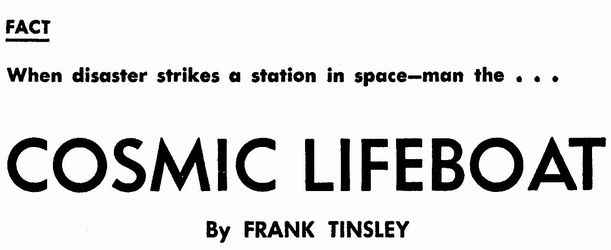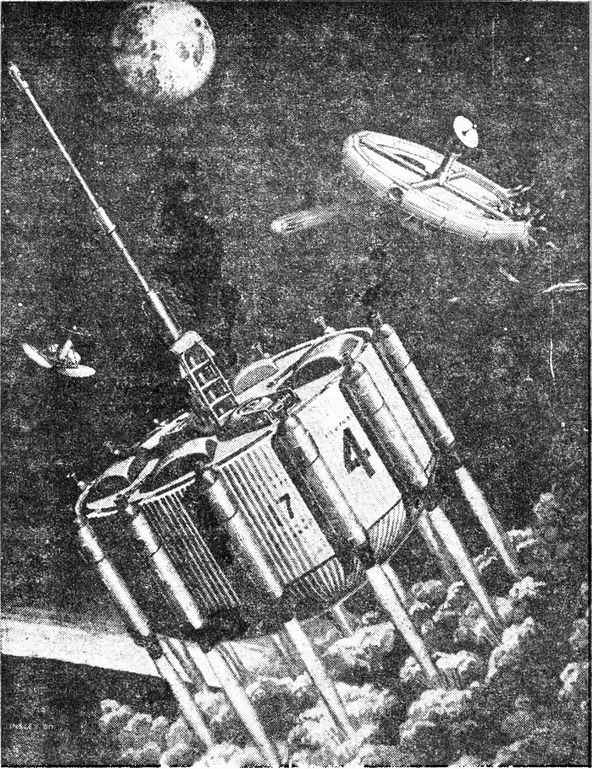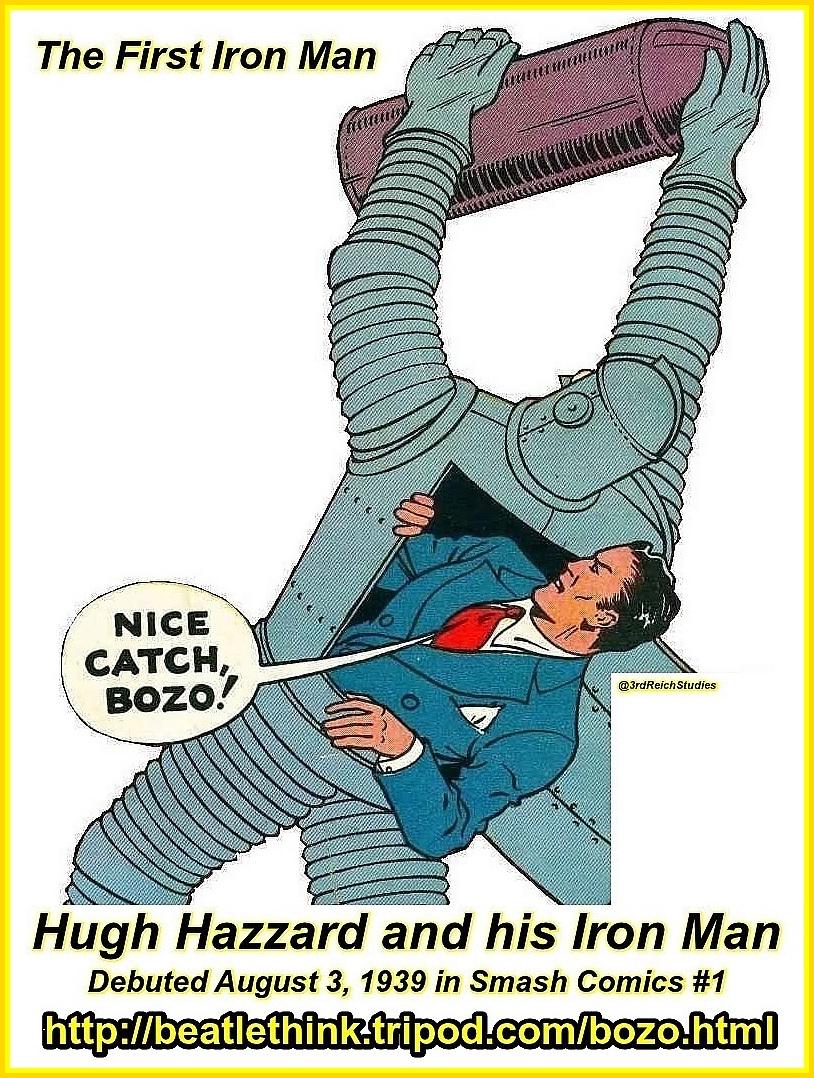Recent previews of the Saturn and Nova projects, and the eventual emergence of other multimillion-pound-thrust power-plants for space vehicles, promise a dramatic breakthrough in tomorrow's payload capabilities. The ability of these herculean machines to lift hundreds of tons of cargo into orbit in a single flight will bring the day of really large, space-assembled satellites far closer than we now realize.
With the advent of such satellite laboratories, carrying considerable crews of engineers and research scientists, will come a host of new problems, both human and technological. Not only must these highly trained individuals be transported to and from their stations and supplied with the means of living and working in reasonable comfort, but for their peace of mind they must also be guaranteed a sure means of escape in the event of mechanical malfunction or outright disaster. The latter could take several forms—deliberate military attack, accidental collision with an off-beam rocket vehicle, or the billion-to-one chance of being hit by a meteorite of dangerous size.
Without quite realizing it, we are already attacking this important problem of human safety in space. Project Mercury, our first attempt to place a man in orbit, is developing techniques and equipment to sustain life, conquer the fiery heat of re-entry into the atmosphere, and provide for dependable communication and rescue. So actually, we can consider this one-man capsule as a test vehicle for the future as well as a current step in the conquest of space. When all the bugs are eliminated and it has been thoroughly proven in practical use, Mercury will provide the basis for larger, more elaborate, multi-place rescue designs. Our illustration shows one of the possible forms that such a "cosmic lifeboat" may take.
The space station shown is designed like a huge wheel revolving around a stationary axle. The turning wheel of course generates centrifugal force, the pull of which grows progressively stronger as one moves outward from the central "hub". In the wheel's tire-like rim, where the living and working quarters are principally located, this outward pull approximates that of normal earth gravity. To visualize life in this artificial world, we must remember that the lower deck rests on the inner surface of the tire tread and that to someone moving about on that floor, or the level above it, the hub is always "up". Compartments in the hub and axle are reached by "ascending" in elevators which move up and down through the four "spokes".
Inside this area of induced gravity and controlled atmosphere, the station's crew lead normal lives and dress in normal clothes. The carbon-dioxide they exhale is absorbed by plants grown in hydroponic gardens, and in the natural growth process new oxygen is manufactured. Thus, fresh, conditioned air is constantly generated and circulated. Power is supplied by solar batteries operating 24 hours a day. Heat or cold can be drawn from the sun or surrounding space. The station is therefore self-supporting in all basic requirements. It is only when these balanced conditions are upset by mechanical failure or outside emergency that some form of escape vehicle is necessary.
The number of escape capsules provided depends, of course, on the satellite's size and the number of its crew. In the design shown—a relatively modest station with a complement of 30 to 35—four "lifeboats" are ample. They nest snugly in the outer tread, one opposite the end of each spoke and convenient to its elevator exit. These escape chambers in the rim are bulk-headed off to form air- and pressure-tight compartments. Inside them, the boats rest on vertical launching rails set into the walls of cylindrical pits, their top decks and hatches flush with the compartment floors.
The lifeboats are round, built like king-size coffee tins, with flat tops and doe-shaped bottoms. They are jacketed with ablation-type heat shields designed to combat the roasting temperatures of high speed reentry into the earth's atmosphere. Mounted on the exterior of the shield is a ring of combination launching and retrorockets. The former, set into the inner end of each rocket, are small RATO bottles, just sufficient to blow the boat clear of its parent station. The latter are longer lived and more powerful, designed to slow the lifeboat's speed and bring it out of orbit when the calculated exit point is reached. The final discharge of the rockets then further decelerates the vehicle as it starts its re-entry dive. After burnout, the rocket shells are jettisoned. The heat shields, fluted to increase their effective area, are offset from the boat body and mounted in interlocking sections around its sides and bottom. These are jettisoned in turn when re-entry has been completed. The boat is thus stripped and lightened for its final parachute landing in a pre-selected sea area.
A retractable mast, set in the center of the lifeboat's upper deck, serves several purposes. When the boat is nested in the parent station the partially telescoped mast extends up through a hatchway in the escape compartment's upper deck and doubles as a "fireman's pole" for fast exits from that level. After emergency ejection, while the boat is traveling through airless space, the mast is extended to its full length and functions as a mass-balanced, stabilizing tail—much like the sticks on Fourth of July rockets. When the boat has finally 'chuted down and is floating on the surface of the sea, the mast serves as a periscope for rough water lookout, a radio antenna mount and a support for the combination sunshade, sail and radar target with which the craft is equipped.
The lifeboat hull is of light metal construction, double-walled and interlined with insulation. It need be stressed only to meet the moderate launching and landing shocks, and its weight is kept as low as possible. Set in its upper deck on either side of the mast housing are twin hatches of generous size to halve entrance and exit time. Ladders lead down the housing root below deck to an ample central floor space at the bottom.
This can be increased by folding down the elevated leg-rests of the Mercury type deceleration beds. There are eight of these radiating outward from the boat's center. Each is custom-molded to its assigned occupant and is fitted with safety-straps, oxygen mask and all necessary equipment. The perimeter walls of the cabin are lined with racks and lockers containing individual survival gear, compressed air tanks, food and water. Although the capsule is pressurized and air-conditioned during flight, escapees are trained to don emergency pressure suits in case of mechanical failure.
Designed primarily for water landings, the lifeboat is completely seaworthy and carries supplies for several weeks. Radio, flares and smoke signals are provided, as well as fishing kits, seasickness pills, shark repellant and all the customary survival equipment. An outsize, inflated ring of rubberized fabric girdles the boat's topsides. This assists the craft's flotation and prevents tipping. It can be patched and re-inflated with the usual life-raft gear. On the underside of the boat is a companion stabilizer in the form of a four foot, tubular keel, weighted on its lower end. Retracted into the root of the mast housing during flight, this counterpoise steadies the craft in rough seas. Under these conditions, life-lines are rigged to protect the watch on deck. They are attached to folding stanchions and the parachute bin covers, which are raised and locked in an upright position to form bulwarks. The inflated fabric sail/parasol, described earlier, may be surfaced with solar batteries to provide auxiliary power for lights, radio, etc.
Let’s substitute ourselves for a space station crew member and see just how this rescue system works. The first indication of trouble flashes on a radarscope in the station's Command Post. A flickering, fast-spreading "blip" signals the approach of an unidentified object heading toward Earth on a path dangerously close to our satellite. The million-to-one risk faced by every working astronaut has suddenly become imminent. It is a high-mass meteorite on the loose! Tracking switches are flipped and a miniaturized computer compares the size, speed and bearing of the cosmic thunderbolt with the station's orbital course and velocity. The answer snaps back in a split second—COLLISION COURSE! Automatically, alarm gongs reverberate through the labs and corridors. Pulsing alarm lights flash above each desk and workbench and the muffled slam of airtight doors signal the sealing of the station into a complex of independently pressurized compartments.
Well trained in escape procedures, the twenty-odd engineers and researchers who comprise her crew drop pencils and instruments and reach for their emergency pressure suits. In all probability, this is just another drill, but they are too well indoctrinated in the dangers of a space blow-out to hesitate. In the Physics Lab we follow suit, hurrying through the routine of checking each other's gear. The pressure gauge in the lab door tells us that the corridor outside is still up to normal and we press the "open" button. This must be one of the Skipper's dry runs. Dutifully, we sprint toward the escape chamber, responding to the inevitable excitement of the drill. Then, completely unexpected, comes a crash of impact and the rending explosion of liberated air!
The shock sends us sprawling. Although the still whirling station maintains its rim gravity, its suddenly eccentric weaving keeps us rolling helplessly. Even through the sound-deadening helmets, the din of tearing, wrenching metal presages the imminent collapse of the whole structure. This is no drill we are running through—no theatrical pretense of danger. This is it! With a supreme effort, we struggle to our feet and reach the end of the heaving corridor. The door gauge brings a thrill of hope—the pressure in the escape chamber is still intact! We punch the operating button.
Inside, the can-shaped escape capsule hangs waiting in its rails, hatches open, telescoped mast reaching up through the emergency hatch in the floor above. As we hesitate, a pressure-suited figure plummets down like a fireman responding to an alarm and disappears into the further hatch. You leap through the nearer opening and I scramble down in your wake.
The eight-man capsule is only half full and as we hit the deck, the Commander's eyebrows go up in query. "This is for REAL! What's keeping the others?" "Did you look into the next bay?" asks the Astronomy Technician who had just slid down the mast. "I got a glimpse as I came down in the elevator. Whatever hits us, came through right next door and the whole rim is in ribbons!"
"Sure?" The Boat Commander stares upward through the silent manholes. There is no further sign of life. "Okay," he mutters in a voice that has gone suddenly hoarse, "Secure hatches!"
We straighten out our deceleration beds, watching hatch-lids descend and latch with grim finality. After a last swift check, the Commander's arms settle in their padded troughs and he throws the takeoff switch. At the top of the central mast-housing, an illuminated count-down panel snaps on and every eye fixes on the flitting numerals. "Four—three—two—one—ZERO!" There is a muted roar as the take-off bottles fire and the capsule quivers in its tracks.
Our bodies rise against the acceleration, then settle back as the straps curb us and the lifeboat slows again. In the periscope reflector, we can see the great wheel-like station whirling crazily as it falls astern. We wonder how the boats from the other sections are doing. Our own "can" has steadied into a slightly lower and faster orbit, its lighter weight drawing it downward in a smooth spiral. A voice sounds from somewhere in the darkened cabin. "We made it!"
"So far . . ." replied the Commander drily. "Now, let's see where we are and how accurately we can set this thing down!"
Stretching out his hand, he reaches for the guidance gear. The compact mechanism goes to work, calculating our speed, altitude and direction, feeding the data into a computer and storing the resulting figures in tiny memory tubes. Pre-set for a rescue area in the Caribbean, this astrogator will fire our belt of retro-rockets at a precise point in our new orbit. This, fortunately, is not far off. In a few minutes a warning light snaps on and we feel the "retros" check our speed. The toughest part of the descent is now at hand—the strain of radical deceleration and the oven-like heat of re-entry into the atmosphere.
The capsule's response to the first thin film of air is scarcely noticeable. Only the gradual color change in the white surface of the heat shield betrays its rising temperature. The atmosphere thickens and the colors progress through the yellow spectrum and on to a rosy red. As the resistance slows the vehicle down, increasing friction takes its fiery toll. Soon, the shield is red hot and its ablative surface begins to sluff off in a trail of molten particles. Inside, protected by an intervening air space and the inner, insulated hull, we watch the temperature gauge level off at a bearable 95 degrees. The heat resistant materials perfected through research during the first Mercury Project permit us to sail through the heat barrier in safety and relative comfort.
Another mile or so and our escape capsule has passed the critical point. As its speed is progressively checked the friction declines and the shielding surfaces cease to ablate. Slowly, the red glow cools to pink and then back through the yellow tones. At last, it darkens to a charred, molten black and the vehicle arcs downward into the troposphere. A controllable velocity has now been attained. As this registers on the guidance mechanism, hinged covers fly open and pilot parachutes pop up from their deck lockers. At the same time, explosive charges blow away the heavy heat shield in smoking sections. This really lightens the craft, and when the main 'chutes blossom their shock is not too bad. Under their restraining brake action the capsule swings gently toward the sea below.
Watching in the periscope reflector we see the rising rollers and brace ourselves for the splash. Absorbed by the resilient beds, the shock is minor. A moment later the 'chutes automatically disconnect and the flotation bags inflate. We open the hatches and scramble up the ladders. We have demonstrated in actual practice that a space station can be evacuated safely. THE END (1961)
Back To:

 Twitter: @3rdReichStudies
Twitter: @3rdReichStudies









Twitter: @3rdReichStudies



>



















